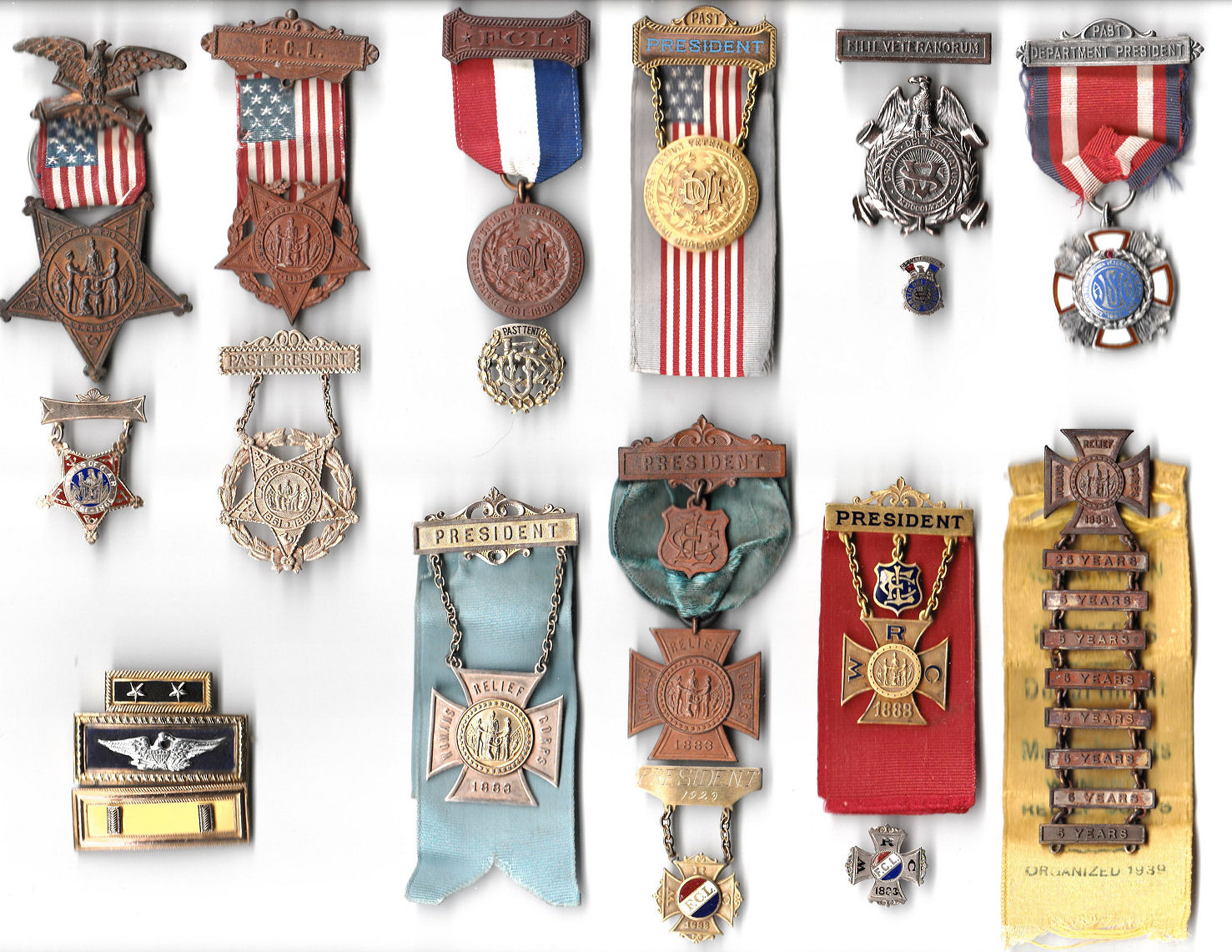Grand Army of the Republic

Shown here: Grand Army of the
Republic and Ladies of the GAR. Daughters of Union Veterans. Sons of Union
Veterans and Ladies Auxiliary to the SUV. Women's Relief Corps. The officer
insignia (lower left) are medal hangers.

History of
the Grand Army of the
Republic - GAR
The history of the GAR has been told many times.
The history was first formalized,1888, in Robert Beath's History of the GAR and
from this source you can trace the various short versions that were extracted and
published over and over. Recently the papers of the founder, Dr. B.F. Stephenson, were
uncovered. These papers were not available when the Beath history was written, because
Beath assumed all of Dr. Stephenson's papers were burned by his wife, following
Stephenson's death in 1871. Beath had few of the early GAR headquarter papers because the
records up to 1868 "were in an imperfect condition" when turned over to
Adjutant-General Chipman, and during a great fire in Boston, 1872, all the books and
records up to that time were burned. The discovery of the Stephenson papers and the
original letter-book of the GAR, in Stephenson's own hand, has given new insight into the
early history of this great union veteran organization.
Dr. B.F. Stephenson founded the GAR in 1866. The
author is convinced he was alone in it's concept, using many friends to proof read his
organizational papers and constitution and to lend guidance. The story of Rev. Rutledge,
as a co-founder, described by Beath, is without merit. The name of Rev. Rutledge does not
appear in any of the early papers or letters. Dr. Stepenson's daughter Mary, in her book
about her father, also discredits the Rutledge story. Dr. Stephenson established the first
Post in a printing office at Decatur, Illinois, because this group of veterans were about
to print his constitution and he wanted them to become members before seeing the document.
The Department of Illinois was established, and
during the first encampment of this department many veterans from surrounding states
attended. The organization spread quickly, and soon posts were formed from Mass. to
California. Dr. Stephenson was not elected National Commander at the first National
Encampment, Indianapolis,1866, but his early correspondence clearly shows he assumed the
position prior to this encampment, as letters were signed, B.F. Stephenson, Commander
of the G.A.R.U.S..
General Logan was elected Commander-in-Chief in
1869, moving the National Headquarters to Washington, D.C. At this point, Dr. Stephenson's
influence had diminished, and the distance between him and the circle of influence in
Washington, almost eliminated him from the GAR . He had moved back to Petersburg, Illinois,
re-establishing an old practice and taking care of his parents. Both his mother and father
passed away during this time and certainly dominated his attention. Dr. Stephenson was
also in poor health, having financial problems with a loss of his investments, and local
debts mounting. In his papers are letters pleading for more time to pay debts and a note
of foreclosure from the sheriff. The sheriff was about to take his horse and buggy, and
other property. In one letter, Dr. Stephenson asked that they might show some mercy, and
let him keep his horse and buggy, as they were necessary to the practice. This transfer of
power from the founder and those around him, to politicians in Washington, is one of the
most important changes in the organization's history. This is a significant change during
the early years of the GAR.
The GAR almost disappeared
during the early
1870's, and many departments ceased to exist. About 1875, new leadership provided the
platform for renewed growth. In 1890, the GAR reached it's largest membership, just over
490,000 members and in 1949, six surviving members permanently closed the GAR. During the
active years of the GAR, the organization had a great influence on politics, law, and
social areas of the United States. Memorial Day was established as a national holiday,
five Presidents were elected that were GAR members, most of the Governors in the northern
states were members, and veteran pensions were given to the union veterans. Over one fifth
of the national budget went toward veteran pensions at one point. The National Encampments
were yearly meetings that had attendance of over 25,000 veterans in 1890, 91 and 92. In
many cases it was impossible to be elected to public office if you were not a veteran of
the Civil War. The GAR membership was often reminded that politics were not to be a part
of the organization, but politics was a major issue throughout the history of the GAR.
Mary Dearing wrote the book Veterans in Politics in the mid 1950's, and it
stands as the definitive work on veteran political activities.
The Grand Army of the Republic
Civil War Museum and Library can be found on the web at:
http://garmuslib.org/

